Creating an Order Action
Once you access the "Define Button" box and (1) enter a name for an Action Button in the "Button Title" field and (2) select an action category in the "Button Action" field, you may assign specific order operations and parameters to an Action Button.
Note: For information regarding the features in the "Define Button" box, refer to the "Adding Action Buttons" section in the "Trade Manager" chapter of Neovest's Help documentation.
The following instructions explain how you may assign specific order operations and parameters to an Action Button:
Click Add Action to access the "Create New Action" box.

The "Create New Action" box contains several features that let you assign specific order operations and parameters to an Action Button.
The following table provides descriptions of the features in the "Create New Action" box.
| Feature: | Description: |
| Name | Lets you enter a name for an action. Once you enter a name, the Create button will become active. |
| Select a Component |
Shows that you wish to create an action for a "Trade Manager"
window.
Note: Neovest lets you create actions for Account, Filter, Montage, Order Entry, Order Entry Montage, QuoteWatch, and Trade Manager windows. |
|
Select
an Action |
Shows that you wish to create a "Single Order" to assign to an action in the selected tab of a Trade Manager window. |
With the "Create New Action" box open on your screen, enter the name in the "Name" field that you wish to give the action. (In the following example, "Buy Listed" is used as the name.)
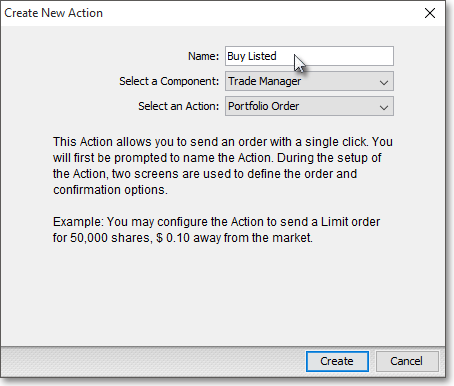
Once the Create button becomes active, click Create.

The following instructions explain how you may assign a Single Order to an action:
Once the "Single Order Action Setup" box appears, select the order parameters on the drop-down menus that you wish for the action.
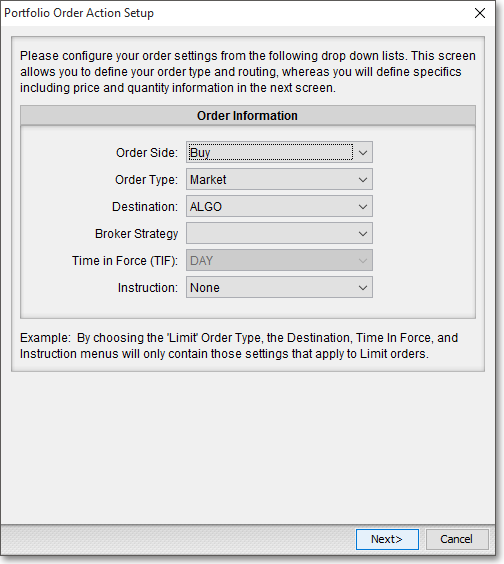
Note: Keep in mind that as you select different order types and destinations in the "Single Order Action Setup" box, the selections in the remaining drop-down menus will automatically update to reveal only those selections that relate to your selected order type and destination.
The following table provides descriptions of the features in the "Single Order Action Setup" box:
| Feature: | Description: |
| Order Side |
Lets you select a side (i.e., "Buy," "Sell," "Sell Short,"
"SSx," or "Buy Cover") for the action. Note: "SSx" stands for "sell short exempt" and may be used with various destinations for short-selling purposes. |
| Order Type |
Lets you select one of several different order types for the action. Note: Each destination supports different order types; therefore, as you select different destinations, the availability of certain order types will change. For complete descriptions of the order types that are displayed in the "Order Type" drop-down menu, refer to the "Stock Order Ticket" and "Order Entry Destinations" sections in the "Orders" chapter of Neovest's Help documentation. |
| Destination | Lets you select a destination for the action. For information on the main destinations that Neovest currently supports, refer to the "Order Entry Destinations" section in the "Orders" chapter of Neovest's Help documentation. |
| Broker Strategy |
Lets you select one of several unique third-party broker algorithmic strategies
for the action.
Note (1): After you select a particular broker strategy and complete subsequent stages of the action setup process, you will reach a final setup box wherein you may specify settings that are specific to the strategy you selected. For example, if you select JPMorgan ("JPMS") as the destination and "VWAP" as the broker strategy, then Neovest will display JPMorgan's "Volume Weighted Average Price" algorithmic strategy parameters in the final setup box, which will let you specify settings for the action based on JPMorgan's VWAP broker strategy. There is an image of the "Broker Strategy" box immediately following this table. Note (2): Each destination provides its own unique broker strategies; therefore, as you select different destinations, the selections in the "Broker Strategy" drop-down menu will change. Neovest does not provide descriptions of the broker strategies that are offered by each destination due to their proprietary nature. For information on the broker strategies that are offered by various destinations, contact your Neovest account manager. |
| Time in Force (TIF) |
Lets you select one of several different order expiration types for the action. Note: Each destination supports different order expiration types; therefore, as you select different destinations, the availability of certain order expiration types will change. For complete descriptions of the order expiration types that are displayed in the "Time in Force" drop-down menu, refer to the "Stock Order Ticket" section in the "Orders" chapter of Neovest's Help documentation. |
| Instruction |
Lets you select an order instruction to send to the selected destination for the
action. Note: Each destination supported by Neovest provides its own instructions; therefore, as you select different destinations, the selections in this drop-down menu will change. For information on the instructions that Neovest currently supports, refer to the "Order Entry Destinations" section in the "Orders" chapter of Neovest's Help documentation. |
Image of the "Broker Strategy" box:
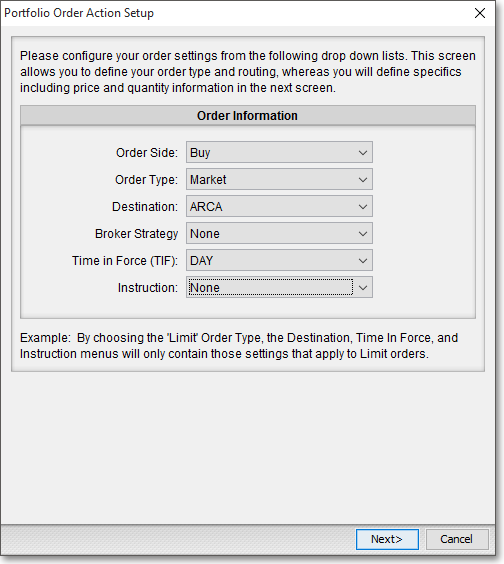
Click Next.

Enter the order parameters you wish in the fields that allow you to enter order information manually, and select the remaining order parameters you wish on the available drop-down menus for the action.
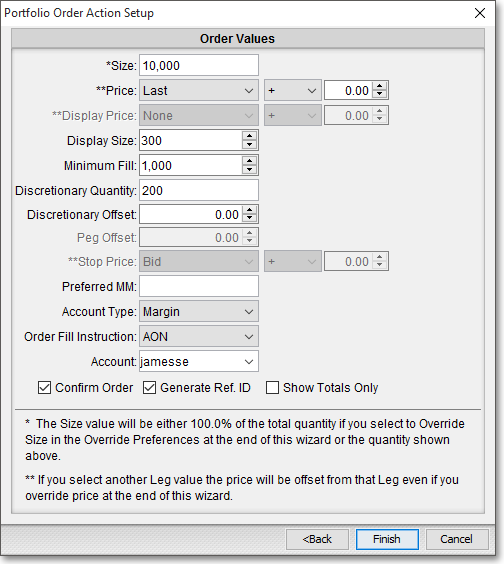
Note: For complete definitions of many of the order components that are displayed in the "Single Order Action Setup" box, refer to the "Stock Order Ticket" section in the "Orders" chapter of Neovest's Help documentation.
The following table provides descriptions of the remaining order components that are not defined in the "Stock Order Ticket" section.
| Feature: | Description: |
| Price |
Lets you specify a price offset for the action. You may offset the Bid, Ask, Last,
Mid Price, MMBid (market maker bid), or MMAsk (market maker ask) price by any positive
or negative amount simply by selecting plus ("+"), minus ("-"),
multiply ("*"), or divide ("/") and by clicking on the up or
down arrows to increase or decrease the offset amount from the default of ".00". Note: "Mid Price" is defined as the midpoint price between the current bid and ask for the entered symbol. |
| Display Price |
Lets you specify a display price offset for the action. You may offset the Bid,
Ask, Last, Mid Price, MMBid (market maker bid), or MMAsk (market maker ask) display
price by any positive or negative amount simply by selecting plus ("+"),
minus ("-"), multiply ("*"), or divide ("/") and by
clicking on the up or down arrows to increase or decrease the offset amount from
the default of ".00." Note: "Mid Price" is defined as the midpoint price between the current bid and ask for the entered symbol. Note: A display price may be used differently in conjunction with different types of orders, so for assistance with specifying a display price, refer to the descriptions of the order types that each Neovest supported destination provides in the "Order Entry Destinations" section of the "Orders" chapter in Neovest's Help documentation. |
| Display Size | Lets you specify a number of shares to be displayed for the action. Specifying a display size value lets you display a lower number of shares than the actual number entered in the "Size" field. This feature is useful when you are sending a large order and you do not wish to influence the price of the entered ticker symbol in either direction. |
| Stop Price |
Lets you specify a stop price offset for the action. This feature only becomes active
if you have selected "Stop" or "Stop Limit" as the order type.
You may offset the Bid, Ask, Last, Mid Price, MMBid (market maker bid), or MMAsk
(market maker ask) stop price by any positive or negative amount simply by selecting
plus ("+"), minus ("-"), multiply ("*"), or divide
("/") and by clicking on the up or down arrows to increase or decrease
the offset amount from the default of ".00." Note: "Mid Price" is defined as the midpoint price between the current bid and ask for the entered symbol. |
|
Account
Type |
Lets you select one of two different account types: Cash or Margin for the action. If you agree to pay cash for the Single Order action once it is filled, then select Cash. If you agree to pay with money from a brokerage account (previously established between you and your broker) for the action once it is filled, then select Margin. |
| Order Fill Instruction | Lets you select one of two different order fill instructions: Partial and AON for the action. If you select Partial, then a portion of the order size may be filled. If you select AON (all or nothing), then all of the order size must be met for the action to be filled. |
| Confirm Order | Lets you determine whether verification is required to send an order. If this feature is checked, then each time you click on an Action Button that has been assigned the action, the "Confirm" box will appear and will require that you click Send to confirm the order. |
|
Generate
Ref. ID |
Lets you specify that you wish Neovest to generate a reference ID for the action. You may utilize reference IDs as identifiers to distinguish individual orders. |
| Show Totals Only | Lets you choose to display only the top portion of the "Confirm" box, which shows only the essentials of each order, once you click on an Action Button that has been assigned the action. |
Click Finish.

Once the "Define Button" box appears, click on the action you just created, or click on an alternate action, to assign the action to the Action Button.
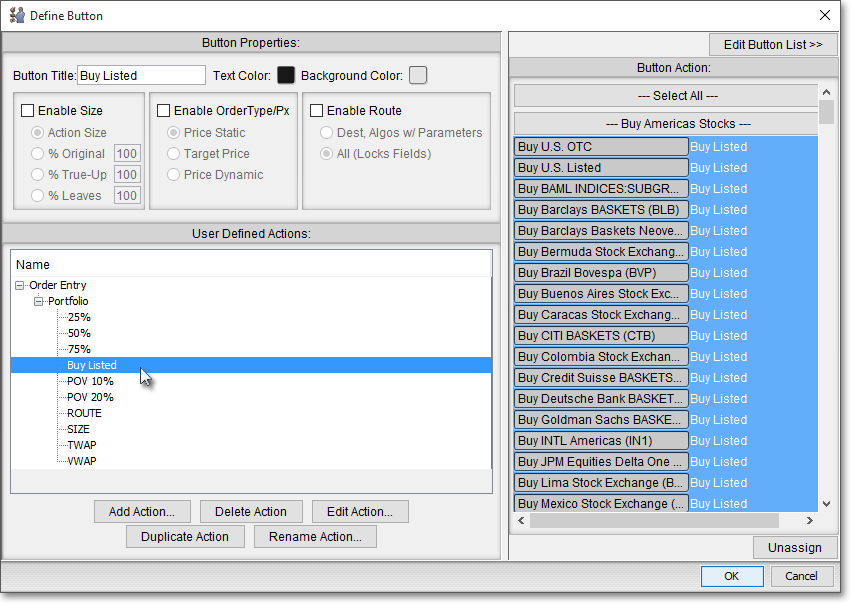
Click OK to add the Action Button, with its assigned action, to the selected tab in a Trade Manager window.

Note: Once the Action Button to which you have assigned the action appears in the selected tab in a Trade Manager window, you may click on the Action Button to automatically open and populate a "Confirm" box with your preset order information.
If the order meets your approval, you may click Send in the "Confirm" box to immediately send the order.
